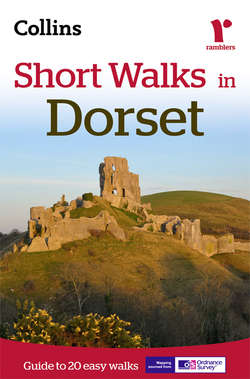Читать книгу Short Walks in Dorset - Collins Maps - Страница 11
Hardy’s Wessex
ОглавлениеThomas Hardy was convinced that ‘it is better for a writer to know a little bit of the world remarkably well than to know a great part of the world remarkably little’. His little bit of the world was Dorset and the surrounding counties, which became his fictionalised Wessex. County boundaries were disregarded, while towns and villages were renamed, often transparently, giving Hardy his own stage upon which his stories were set. Hardy’s Wessex became vividly detailed, making its exploration fascinating.
The landscape of Hardy’s Wessex is far from uniform. Its variety is striking, from the Vale of the Little Dairies to the wilds of Egdon Heath and the inspiring Wessex Heights. Its core is Hardy’s native parish of Stinsford (the ‘Mellstock’ of the novels). Hardy was born here in a cottage at Higher Bockhampton in 1840. This was then a wild, lonely place where ‘snakes and efts swarmed in the summer days, and nightly bats would fly about our bedrooms’. The most prominent features of Hardy’s boyhood environment were the Heath and the River Frome, which separates Bockhampton from the county town of Dorchester. Hardy gave the individual heaths, which extend to Poole Harbour, the collective name of Egdon Heath, where the outlook was ‘lone and bare’. The wild beauty of this excited Hardy’s imagination, especially in The Return of the Native, where Clym Yeobright ‘was permeated with its scenes, with its substance, and with its odours’. In The Mayor of Casterbridge, Hardy described the heath as ‘that ancient country whose surface never had been stirred to a finger’s depth, save by the scratching of rabbits, since brushed by the feet of the earliest tribes’. Only small pockets of this heathland have survived the agricultural improvements and the dense conifer afforestation of the 20th century,
The River Frome flows eastwards to Poole Harbour. Its green, fertile valley was where the waters ‘were as clear as the pure River of Life shown to the Evangelist, rapid as the shadow of a cloud, with pebbly shallows that prattled to the sky all day long’. In autumn the river filled up and ‘the smallest gullies were all full; there was no taking short cuts anywhere, and foot passengers were compelled to follow the permanent ways’. Angel Clare courted Tess here, ‘in the valley her spirits up wonderfully’ upon first sight. This is still a lush, dairy-farming landscape, although the milkmaids have been replaced by machines. Here was a rich seam from which Hardy could link the environment with human emotions, as in Tess of the d’Urbervilles: ‘Amid the oozing fatness and warm ferments of the Froom Vale, at a season when the rush of juices could almost be heard below the hiss of fertilization, it was impossible that the most fanciful love should not grow passionate. The ready bosoms existing there were impregnated by their surroundings’.
The Vale of Blackmoor, or Blackmore, was the home of Tess. Its gateway is Sturminster Newton, past which flows the River Stour and it is best seen from the surrounding heights. The river and its tributaries give the vale its character, enhanced by the villages which cluster on islands of higher ground above land liable to flooding. Hardy wrote in The Woodlanders that the Vale ‘cannot be regarded as inferior to any inland scenery of the sort in the west of England, or perhaps anywhere in the Kingdom’. The heavy clay soil is the kind where Hardy felt ‘superstitions linger longest’. The trees relate to humans, as in The Woodlanders, when Marty South remarked that the young pines she was planting seemed to ‘sigh because they are very sorry to begin life in earnest - just as we be’.
The downland ridges of Dorset were Hardy’s Wessex Heights, ‘where men have never cared to haunt nor women have walked with me, and ghosts then keep their distance; and I know some liberty’. The north Dorset escarpment overlooking the Vale of Blackmore constantly recurs in the novels. Here is the scene of Tess’s poverty-stricken winter at Flintcombe-Ash, ‘a starve-acre place’ where ‘Tess slaved in the morning frosts and in the afternoon rains’. Not far from here is the Giant of Cerne Abbas, the ‘Cernel Giant’ who ate babies in ancient times, according to Mrs Cantle in The Dynasts. This is also sheep country and Hardy wrote of the sheepfair at ‘Greenhilll’ (Woodbury Hill) outside ‘Kingsbere’ (Bere Regis), the annual gathering on the top of a hill attended by ‘multitude after multitude’ of ‘horned and hornless’ sheep. Nearby is Tolpuddle, the home of the trade union Martyrs. Their trial was held in Dorchester, Hardy’s ‘Casterbridge’ and the town most closely associated with the novelist.
Hardy’s Wessex also has fine coastal scenery. Weymouth was only 10 miles (16km) from Hardy’s home and he was fond of ‘the boats, the sands, the esplanade’. Hardy wrote Desperate Remedies, his first published novel, in Weymouth, but The Trumpet Major and The Dynasts are the fruits of a longer association with the coast. Hardy’s grandparents remembered when this coastline was under threat of invasion by Napoleon, and folk-memories and legends from the time enliven Hardy’s works. The Hand of Ethelberta is the novel of Purbeck. This ‘isle’ is a microcosm of the Dorset landscape, with chalk, clay, limestone, sand and shale, rugged and gentle scenery. It is reached through the gap guarded by Corfe Castle which, like the cliffs and headlands of Purbeck, was visited frequently by Hardy. The newly-married Thomas and Emma Hardy walked the cliffs east of Swanage, where the detached stumps of chalk stand witness to the power of the waves. Further west, towards Weymouth, the spectacular cove at Lulworth is where Sergeant Troy was thought to have drowned in Far from the Madding Crowd.
